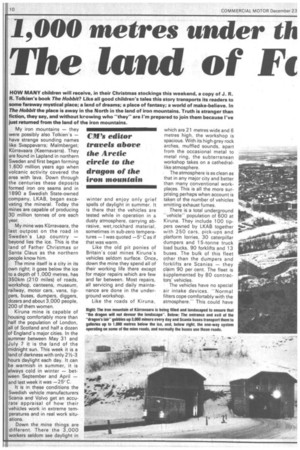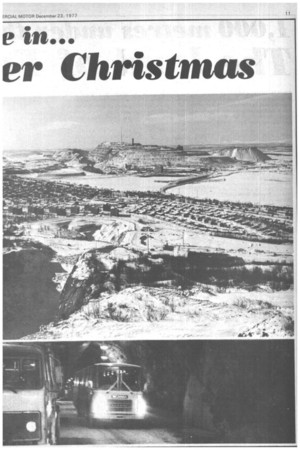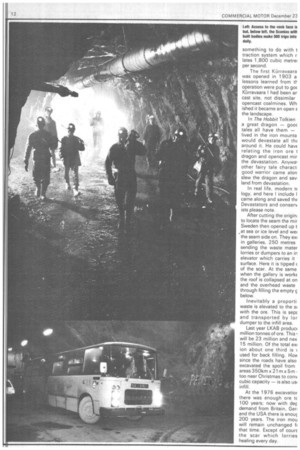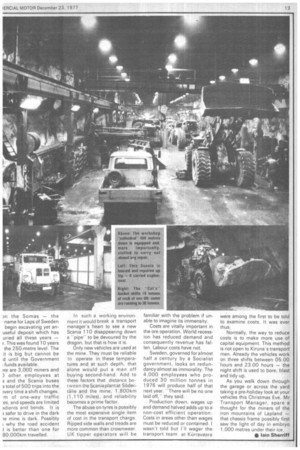1,000 metres tinder th P in...
Page 12

Page 13

Page 14

Page 15

If you've noticed an error in this article please click here to report it so we can fix it.
The land of Fe
er Christmas
HOW MANY children will receive, in their Christmas stockings this weekend, a copy of J. R. R. Tolkien's book The Hobbit? Like all good children's tales this story transports its readers to some faraway mystical place; a land of dreams; a place of fantasy; a world of make-believe. In The Hobbit the place is away in the North in the land of iron mountains. Truth is stranger than fiction, they say, and without krowing who "they" are I'm prepared to join them because I've just returned from the land of the iron mountains.
My iron mountains — they were possibly also Tolkien's — have strange sounding names like Svappavarra; Malmberget; Kurravaara (Keernavarra). They are found in Lapland in northern Sweden and first began forming 1,600 million years ago when volcanic activity covered the area with lava. Down through the centuries these deposits formed iron ore seams and in 1890 a Swedish State-owned company, LKAB, began excavating the mineral. Today the mines are capable of producing 30 million tonnes of ore each year.
My mine was Kurravaara, the last outpost on the road in Sweden's Lap country — beyond lies the ice. This is the land of Father Christmas or Santa Claus as the northern people know him.
The mine itself is a city in its own right; it goes below the ice to a depth of 1,000 metres, has 350km (210 miles) of roads, workshop, canteens, museum, railway, motor cars, vans, tippers, buses, dumpers, diggers, dozers and about 3,000 people, 200 of them women.
Kiruna mine is capable of housing comfortably more than half the population of London, all of Scotland and half a dozen f England's major cities. In the summer between May 31 and uly 7 it is the land of the midnight sun. This week it is a land of darkness with only 21/2-3 hours daylight each day. It can be warmish in summer, it is lways cold in winter — beteen September and April — and last week it was —25' C. It is in these conditions the Swedish vehicle manufacturers Scania and Volvo get an accurate appraisal of how their vehicles work in extreme ternperatures and in real work situations.
Down the mine things are different. There the 3,000 workers seldom see daylight in
winter and enjoy only grief spells of daylight in summer. It is there that the vehicles are tested while in operation in a dusty atmosphere, carrying abrasive, wet,rockhard material, sometimes in sub-zero ternperatures — I was quoted —5'' C as if that was warm.
Like the old pit ponies of Britain's coal mines Kiruna's vehicles seldom surface. Once, down the mine they spend all of their working life there except for major repairs which are few and far between. Most repairs, all servicing and daily maintenance are done in the underground workshop.
Like the roads of Kiruna, which are 21 metres wide and 6 metres high, the workshop is spacious. With its high grey rock arches, muffled sounds, apart from the occasional metal to metal ring, the subterranean workshop takes on a cathedrallike atmosphere.
The atmosphere is as clean as that in any major city and better than many conventional workplaces. This is all the more surprising perhaps when account is taken of the number of vehicles emitting exhaust fumes.
There is a total underground "vehiclepopulation of 600 at Kiruna. They include 100 tippers owned by LKAB together with 250 cars, pick-ups and platform lorries, 30 caterpillar dumpers and 15-tonne truck load bucks, 90 forklifts and 13 buses. The bulk of this fleet other than the dumpers and forklifts are Scanias — they claim 90 per cent. The fleet is supplemented by 80 contractors' vehicles.
The vehicles have no special air intake devices. "Normal filters cope comfortably with the atmosphere." This could have
something to do with t traction system which r lates 1,800 cubic metre: per second.
The first Kurravaara was opened in 1903 a lessons learned from tioperation were put to goc Kiirravaara I had been ar cast site, not dissimilar opencast coalmines. Wh ished it became an open s the landscape.
In The Hobbit Tolkien a great dragon — gooc tales all have them — lived in the iron mounta would devastate all ill( around it. He could havE relating the iron ore I dragon and opencast mir the devastation. Anywa, other fairy tale charact. good warrior came alon slew the dragon and say. land from devastation.
In real life, modern tE logy, and here I include I came along and saved thE Devastators and conserv ists please note.
After cutting the origin; to locate the seam the mir Sweden then opened up t • at sea or ice level and wet the seam side on. They exi in galleries, 250 metres sending the waste mater lorries or dumpers to an in elevator which carries it • surface. Here it is tipped of the scar. At the same when the gallery is workE the roof is collapsed at on and the overhead waste through filling the empty c below.
Inevitably a proporti waste is elevated to the st with the ore. This is sepE and transported by lor dumper to the infill area.
Last year LKAB product million tonnes of ore. This ■ will be 23 million and nex 15 million. Of the total ext ion about one third is used for back filling. Hom since the roads have also excavated the spoil from areas 350km x 21m x 5m too near Christmas to cony cubic capacity — is also usi inf ill.
At the 1976 excavatior there was enough ore tc 100 years; now with dep demand from Britain, Geri and the USA there is enouc. 200 years. The iron mou will remain unchanged ft that time. Except of courE the scar which lorries healing every day.
an the Somas — the • name for Laps of Sweden begin excavating yet anuseful deposit which has uried all these years — r. This was found 10 years the 250-metre level. The it is big but cannot be d until the Government , funds available.
re are 3,000 miners and ) other employees at 3 and the Scania buses a total of 500 trips into the very time a shift changes.
• rn of one-way traffic :es, and speeds are limited adients and bends. It is s safer to drive in the dark le mine is dark. Possibly why the road accident I is better than one for 80,000km travelled. In such a working environment it would break a transport manager's heart to see a new Scania 110 disappearing down a "pipe" to be devoured by the dragon, but that is how it is.
Only new vehicles are used at the mine. They must be reliable to operate in these temperatures and at such depth, that alone would put a man off buying second-hand. Add to these factors that distance between the Scania plant at Sodertalie and the mine, 1,800km (1,110 miles), and reliability becomes a prime factor.
The abuse on tyres is possibly the most expensive single item of cost in the transport charge. Ripped side walls and treads are more common than crownwear. UK tipper operators will be familiar with the problem if unable to imagine its immensity.
Costs are vitally important in the ore operation. World recession has reduced demand and consequently revenue has fallen. Labour costs have not.
Sweden, governed for almost half a century by a Socialist government, looks on redundancy almost as immorality. The 4,000 employees who produced 30 million tonnes in 1976 will produce half of that next year. "There will be no one laid off,'' they said.
Production down, wages up and demand halved adds up to a non-cost efficient operation. Costs in areas other than wages must be reduced or contained. I wasn't told but I'll wager the transport team at Kiirravaara
were among the first to be told to examine costs. It was ever thus.
Normally, the way to reduce costs is to make more use of capital equipment. This method is not open to Kiruna's transport men. Already the vehicles work on three shifts between 05.00 hours and 23.00 hours — the night shift is used to bore, blast and tidy up.
As you walk down through the garage or across the yard taking a pre-holiday look at your vehicles this Christmas Eve, Mr Transport Manager, spare a thought for the miners of the iron mountains of Lapland — that chassis frame possibly first saw the light of day in embryo 1,000 metres under their ice. • lain Sherriff




































































